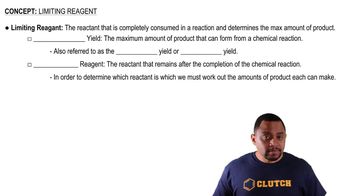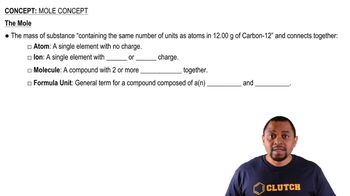Hydrobromic acid dissolves solid iron according to the reaction:
Fe(s) + 2 HBr(aq) → FeBr2(aq) + H2(g)
What mass of HBr (in g) do you need to dissolve a 3.2-g pure iron bar on a padlock?

 Verified step by step guidance
Verified step by step guidance



Hydrobromic acid dissolves solid iron according to the reaction:
Fe(s) + 2 HBr(aq) → FeBr2(aq) + H2(g)
What mass of HBr (in g) do you need to dissolve a 3.2-g pure iron bar on a padlock?
For each of the reactions, calculate the mass (in grams) of the product that forms when 15.39 g of the underlined reactant completely reacts. Assume that there is more than enough of the other reactant.
a. 2 K(s) + Cl2(g) → 2 KCl(s)
b. 2 K(s) + Br2(l) → 2 KBr(s)
c. 4 Cr(s) + 3 O2(g) → 2 Cr2O3(s)
d. 2 Sr(s) + O2(g) → 2 SrO(s)
Find the limiting reactant for each initial amount of reactants. 4 Al(s) + 3 O2( g) → 2 Al2O3(s)
a. 1 mol Al, 1 mol O2
b. 4 mol Al, 2.6 mol O2
c. 16 mol Al, 13 mol O2
d. 7.4 mol Al, 6.5 mol O2
Consider the reaction: 4 HCl(g) + O2(g) → 2 H2O(g) + 2 Cl2(g) Each molecular diagram represents an initial mixture of reactants. How many molecules of Cl2 form from the reaction mixture that produces the greatest amount of products?
Consider the reaction: 2 CH3OH(g) + 3 O2(g) → 2 CO2(g) + 4 H2O(g) Each of the molecular diagrams represents an initial mixture of the reactants. How many CO2 molecules form from the reaction mixture that produces the greatest amount of products?